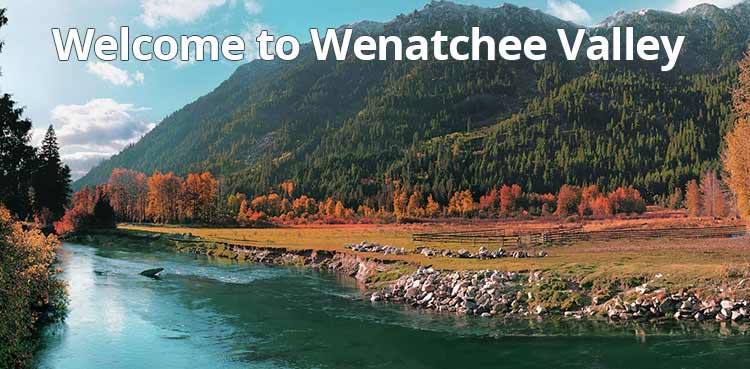Valley History
Western civilization began in Chelan County in 1811 when fur traders of the British Northwest Fur Company (later part of the Hudson Bay Company) began traveling on the upper Columbia River. Brigades of trappers and traders plying river craft between Fort Okanogan, Fort Colville western Canada and lower Columbia River posts such as Fort Vancouver, stopped along the riverbanks of the Chelan area and also trapped in the Chelan, Entiat and Wenatchee Valleys. David Thompson, a British explorer attached to the Northwest Fur Company explored the upper Columbia River Basin between 1807 and 1811 and presumably recorded the first observations of the area.
Fur traders made the first contact with the Wenatchi Indians who inhabited the Columbia River drainage now in Chelan County. The Wenatchi were semi-nomadic hunters, horsemen and river dwellers who had villages along the Columbia and Wenatchee Rivers and on Lake Chelan. They were an interior Salish language group closely related to the Okanogan, Kalispell, San Poil, Colville and Spokane Indians who lived along the Northern Columbia River. The Indians learned rudiments of agricultre from the fur traders and early missionaries.
Americans did not settle in Chelan County until after 1860. The territorial dispute between the United States and Britain had discouraged homesteading. American jurisdiction over the area was established after the Treaty of 1846 which ended British claims in north central Washington and established the Canadian border. However, hostility of the Yakama Comfederacy of Tribes prevailed until 1858 and U.S. Army orders prohibited white settlement in most of eastern Washington areas between 1846 and 1859. A treaty between the United States and the Yakima Confederacy signed at Walla Walla in 1855 and ratified by Congress in 1859 brought about more peaceful conditions. Large reservations—The Yakima and Colville—were established for the Indians. A small reservation, the Wapato, was subsequently established on Lake Chelan. Wenatchi Indians moved onto the reservations or were given land allotments.
The first white settlers were gold prospectors, cattlemen and missionaries. Cattlemen used routes through Chelan County to drive cattle to the gold fields of Canada and northern Washington. An important early arrival was the Catholic missionary, Father Respari, who came to the Wenatchee Valley in 1863. He was followed in 1883 by Father DeGrassi, who is credited with starting irrigation at Cashmere and teaching agriculture to Indians of that district.
Farm settlement in the Chelan County valleys was slow in getting underway. It was not until the 1820′s, after construction of the Great Northern Railway through the Wenatchee Valley in 1892-93 that any appreciable agricultural settlement started. Before that, a limited amount of wheat and livestock moved on the upper Columbia River by stern-wheel steamers. When the Great Northern line was built to Wenatchee, this settlement became an important point of trans-shipment from river vessel to rail transportation. Most homesteaders grew field crops of grain and hay for local markets and some livestock was driven overland to railroad points.
Largely by trail and error and through chance, homesteaders in north central Washington had discovered how well tree fruits such as apples and pears grew in the valley irrigated plots. The excellent manner in which fruit grew in this mountain valley region had been demonstrated in the 1860′s and 1870′s in the Okanogan Valley to the north. There, Hiram F. “Okanogan” Smith planted an orchard of 1,200 trees near Oroville to become the founder of orchard farming. During the 1890′s a few farmers in the Wenatchee Valley began selling boxes of apples commercially to buyers who shipped them by rail to Seattle. Apples of this early period were of varieties now largely obsolete—such as, Spitzenburg, Baldwin, Pearmain, Ben Davis, Wolf River and Arkansas Black.
By 1900 Chelan County has a population of 3,931 and through land development and an orchard planting boom, in the next 10 years grew to 15,104. This decade was active in building irrigation facilities, organizing fruit growers and expanding the marketing of fruits.
While there were fluctuations in the export volume of fruit, such as the 1914-1918 World War I period, the agriculture and commercial economy continued to grow. By 1930, the population reached 31,634. Improved rail service and highway transportation across the Cascade Mountains improved marketing conditions. The economic base of the county began to expand after 1940 to include new types of employment in lumber, mining, hydroelectric construction, food processing and electrical refining of metal. A key to new industries was the abundant hydroelectric power created by Grand Coulee and Rock Island Dams. Large new payrolls were created by the Aluminum Company of America (Alcoa) plant near Malaga, the Holden Mining Company at Lake Chelan and the Rock Island Dam. Population grew by 5,000 during World War II years as industrial activity and food processing employment expanded. In 1955 Chelan County reached a population of 42,000 supported by agriculture and new industries.
This historical summary has been derived from these sources:
(1) Washington, A guide to the Evergreen State, (American Guide Series), Writerr’s Program of the Works Projects Administration State of Washington. Sponsored by the Washington Historical Society , 1941.
(2) The Counties of Washington, Perry Richard M., Secretary of State, Olympia, Washington 1943 (Mimeographed).
(3) The Wenatchee Daily World, Festival Edition, May 6, 1953, Wenatchee, Washington
(4) The Wenatchee Daily World, “50th Anniversary Year Edition”, July 3, 1955, Wenatchee, Washington
(5) http://www.nass.usda.gov/wa/counties/chelan1.pdf
